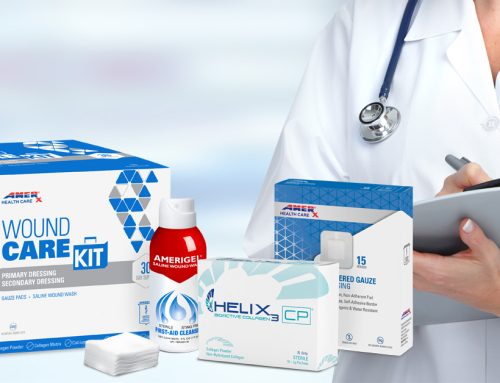When dispensing surgical dressings, it is important to differentiate between primary and secondary dressings and to use them in conjunction when indicated.
- PRIMARY DRESSINGS: Primary dressings are therapeutic or protective and can be applied directly to ulcers.
- SECONDARY DRESSINGS: Secondary dressings are needed to secure and/or aid in the function of a primary dressing.
A primary and a secondary dressing can both be dispensed at the same time for the same ulcer when indicated. For example, collagen powder as a primary and foam as a secondary can be dispensed together for the same ulcer.
Guidelines
When dispensing both a primary and secondary dressing for the same ulcer at the same time, certain guidelines must be followed:
- The medical necessity for both should exist and be documented
- Two primary dressings should not be dispensed at the same time for the same ulcer.
- The primary and secondary dressings should not have different indications.
Change Frequencies
The DMEMAC LCD for surgical dressings tells us that “when combinations of primary dressings, secondary dressings, and would fillers are used, the change frequencies of the individual products should be similar.” It does not say they have to be identical.
A good example is the one given above, collagen powder and foam. A 30-day supply for daily change and a 12-day supply for a change every 2-3 days are not identical, but certainly are similar. The LCD goes on to instruct that in a situation like this, “the product in contact with the wound determines the change frequency.” This does not impact quantity restrictions on either product. In our example above, 30 days of collagen and 12 days of foam may be dispensed at the same visit when indicated.
Conclusion
Dispensing both a primary and secondary dressing for the same ulcer at the same encounter can provide excellent, thorough patient care, and also improve profits enjoyed when participating in the surgical dressing program.
When dispensing both a primary and secondary dressing for the same ulcer at the same encounter, be sure the guidelines above are followed and remember that when the two dressings have different, but similar, change frequencies, it is the dressing in contact with the wound that determines the change frequency.
DISCLAIMER: The information provided here is intended to educate health care providers regarding compliance for ICD, CPT, and HCPCS coding. The information provided does not guarantee reimbursement and is accurate to the best of our knowledge at the time of this publication. Coding guidelines can change and we encourage you to stay up to date. The existence of a code does not guarantee payment.

Dr. Jeffrey D. Lehrman, DPM, FASPS, MAPWCA, CPC, CPMA
Dr. Lehrman is a podiatrist practicing in Fort Collins, CO and operates Lehrman Consulting, LLC which provides consultation services regarding coding, compliance and documentation. Dr. Lehrman is a Certified Professional Coder and Certified Professional Medical Auditor. He serves as a staff liaison at the AMA CPT® Editorial Panel meetings where CPT codes are created, edited, and deleted. He is a Diplomate of the American Board of Foot and Ankle Surgery, Fellow of the American Society of Podiatric Surgeons, and is recognized as a “Master” by the American Professional Wound Care Association. Dr Lehrman is a Fellow of the American Academy of Podiatric Practice Management, Past Director of the American Professional Wound Care Association Board of Directors, and is a Past Chairman of the Board of the American Society of Podiatric Surgeons. Dr. Lehrman is also on the editorial advisory board of the journal WOUNDS.





